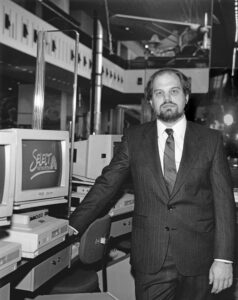by James Hyder
I got my start in the GS world in the summer of 1984, when I was hired as a part-time evening and weekend manager at the National Air and Space Museum’s Samuel P. Langley IMAX Theater by theater manager Ron Wagaman. I had just earned my bachelor’s degree from St. John’s College in Annapolis, MD, after working for seven years in audio-visual production between high school and college.

After a few months at NASM I was promoted to full-time box office manager, then progressed to technical manager and acting theater manager, before being appointed to the newly created position of film distribution manager.
By the early 1990s, NASM had participated in the production of several GS films, with more in the offing. The Smithsonian‘s National Museum of Natural History was about to open a new IMAX theater, and would also be making films. Wagaman believed that by distributing its own GS films the Smithsonian could create a significant new revenue stream, and I was charged with developing a business model to make the case for an in-house GS film distribution office. With help from MacGillivray Freeman’s Bill Bennett and several other GS colleagues, I showed that, using conservative assumptions, the office would be able to net more than $1 million a year within a few years.
However, at the time the Smithsonian was steeped in academic tradition and almost virulently anti-commercial in its outlook. The plan was not approved, and I was channeled into other tasks within the museum, mostly in the burgeoning IT department, even though I retained the title of film distribution manager, and continued to assist with the museum’s GS films and represent the museum at GS conferences.
When the Smithsonian mandated an institution-wide reorganization and reduction in force in 1996, someone probably asked the logical question, “Why do we have a film distribution manager who’s not distributing films?” and I was among more than 20 people laid off, including my erstwhile boss, Wagaman, who by then had been promoted to assistant museum director for operations.
I learned I would be losing my job two days before the 1996 International Space Theater Consortium conference was to start in Barcelona. Although I had gone to most conferences before this, I was not among the museum’s delegation this time, probably because someone knew or guessed I was a short-timer. So on very short notice (and at considerable expense) I booked a flight and hotel so that I could start the search for my next job.

On my first day in Barcelona, I was having lunch in a restaurant with a few colleagues, including Larry O’Reilly, who was developing Natural History’s IMAX theater (not to be confused with the Imax Corp. employee of the same name). On learning of my fate, Larry said, “Someday someone’s going to start a newsletter for this business and make a million dollars,” pointedly adding, “And all I want is 10% for the idea.” My eyes lit up, and on the flight back home I was sketching out what the newsletter would look like and considering names.
I was fortunate that the Newsletter Publishers Association was headquartered in Washington, DC, and through them a prominent consultant generously agreed to advise me for the price of a lunch. My grandiose plans were soon dashed when he explained that since the most successful newsletters capture only about 5% of their “universe” of potential subscribers, I would need a base of at least 10,000 to support even a one-person operation. I estimated the GS industry at the time employed about 2,000. He said that getting 20–25% of that market to subscribe would be simply unheard of.
Fortunately, my 12 years at NASM had entitled me to a severance package of 12 months of salary, so I had the luxury of time to consider my options. I briefly continued trying to salvage the newsletter concept, but by early 1997 I had given up on the idea and was searching, vainly, for jobs as a GS theater manager, the position I was most qualified for on paper, but for which I had little enthusiasm.
As the spring of 1997 headed into summer, with no promising job prospects, I imagined myself five or ten years hence, in a job I hated, possibly not even in the GS world, asking “Why didn’t I try the newsletter?” The fall conference in Vancouver would be the prime opportunity to promote it, so I took the plunge, and created a four-page mockup announcing the launch of MaxImage! (The name was changed to LF Examiner in 2000.)
About 900 people attended that conference, which ran Sept. 19–21. By the end of 1997 I had 130 subscribers, by the September 1998 issue I had 258, and a year after that I had nearly 400, the 20% of the market my advisor had said would be virtually impossible to achieve. (When I saw him sometime later and told him of my success, he was stunned but congratulatory, and impressed with the amount of information I put in each issue.)
I was fortunate that the number of IMAX and GS theaters in museums was on the rise, and the spread of IMAX screens into multiplexes was just beginning. Interest in GS films and theaters, as reflected by attendance at industry conferences, peaked in 1999, when 1,000 people came to the ISTC conference in New York City. My subscriber count reached its zenith a year later, at just over 500. The count of non-multiplex GS theaters topped out at 270 in 2003. Five years later, as digital projection was introduced and the number of multiplex IMAX theaters began to skyrocket, the institutional segment had begun a slow decline which continues today.
I have often described myself as a “reluctant entrepreneur.” Unlike most newsletter publishers, whose main focus was building their businesses by developing new publications and hiring content experts to write and edit them, I was mostly interested in my subject matter, and saw business tasks, like marketing and business development, as necessary evils that allowed me to do what I most enjoyed: reporting on the GS world.
If I had been like other publishers, on seeing the start of a decline in GS theaters I would have acted to broaden the focus of the newsletter to other growing, or at least larger, segments, like planetariums, fulldomes, theme parks, etc. In fact, I considered these options, but like the proverbial frog in the pot of water, there was no one moment when the pain was so great that I was forced to make the jump.
LF Examiner also remained a print-only publication long after most newsletters had gone digital because the size of my tiny (and shrinking) market made it economically unfeasible to make that transition. As one would-be competitor to LFX found, in the early 2000s it was fiendishly expensive to build an online publication from scratch. By the time those costs had come down, years later, so had my subscriber list.
Over the last decade, as my retirement age approached, trying to go digital or expand the business seemed pointless, so a few years ago I resolved to simply allow LF Examiner to fade away. It has been a good run.
Subscribers
The number of people who have helped me and LFX runs to the thousands. To start, 1,621 people have subscribed to the newsletter over the years. Since 1997 I have sent out just over 59,000 separate copies of the publication, which means that the average subscriber received 36 issues, more than four years’ worth. (Although I started out publishing 12 issues a year, after a couple of years I realized I couldn’t keep up that pace and dropped to ten a year; later I reduced it to eight.)
Among my subscribers, 14 have been especially loyal, receiving at least 200 out of the 216 regular issues published. They include Valentine Kass, Greg MacGillivray, Glenn Shaver, Gordon Stalans, and Holly Wentworth. The following four all subscribed within the crucial first year and maintained their subscriptions for most of the rest of the run: Ed Capelle, Graeme Ferguson, Cassandra Henry, and Jeffry Johnson.
Charlotte Brohi and Mark Katz started their subscriptions with the very first issue.
And three people have the distinction of having received every one of the 216 regular issues and 11 Yearbooks published:
David Clark
David Duszynski
Michael Einkörn
My sincere thanks to everyone who subscribed, but especially to these devoted subscribers.
Special thanks also to Lisa Muscanere at Cinemark Entertainment and Regal Cinemas’ Ted Hatfield, who were such fans of LF Examiner that they arranged for subscriptions for every IMAX theater manager in their respective chains for several years.
Authors
Another group of significant supporters are the 141 GS professionals who wrote articles for the newsletter, their only compensation being a free subscription.

By far, the most significant of these is Marty Shindler, who wrote a regular column that appeared in every issue from Vol. 1 No. 2 (Nov. 1997) through Vol. 7 No. 1 (Nov. 2003), as well as a few additional pieces after that, a total of 64 articles. Marty’s columns, mostly on the business side of GS filmmaking, were perceptive, astute, and provided insights into areas I was unqualified to cover. And they were always submitted on time! He was a pleasure to work with, always graciously accepting my editorial comments and suggestions. Marty’s experience and reputation gave my fledgling publication a significant boost as it started out, and I am sincerely grateful for his support, generosity, and friendship.

Other industry experts who each wrote multiple articles for LFX include Diane Carlson, Peter Crane, Paul Fraser, Gordon Harris, Judith Rubin, and Bayley Silleck. Their unique perspectives broadened the scope of LFX’s coverage and made it a better, more useful, and more valuable publication. My thanks to you and the dozens of other writers whose work I was privileged to publish.
Data providers
One of my goals in starting the newsletter was to provide the GS industry with information and data that wasn’t available from any other source. Two features intended to fulfill that objective appeared in every issue: the listing of GS films In Production, with updates on their status; and the bookings lists, showing which films were playing in which theaters during the current month. Essential to being able to present that data were my contacts at virtually every GS production and distribution company.
Two weeks before going to press for each issue I would e-mail producers requesting updates on their films in production, and send each distributor the list of bookings I had for their films in release, asking for corrections and updates. Although sending production updates was fairly simple and straightforward for producers, providing accurate bookings data was a painstaking and somewhat tedious task (on both sides), but one that every one of my distributor contacts did routinely, for every issue, without complaint, for 24 years. With their help, we reported 39,013 bookings of 485 films in 1,013 theaters. My deepest thanks to all of them for their dedication, patience, and attention to detail.
Endorsers
Big-name filmmakers Brett Leonard, Frank Marshall, Greg MacGillivray, Steve Oedekerk, and Simon Wincer all stunned me by agreeing to endorse LFX in direct mail promotional letters in its first few years. I suspect I would have had substantially fewer subscribers if not for the endorsements of these talented (and generous) filmmakers. They have my sincere thanks.
One-and-onlys
Many individuals have made important contributions to the success of LFX over the years. I am eternally grateful to Larry O’Reilly for suggesting the idea of the newsletter in Barcelona in September 1996. (By the way, I didn’t end up making millions, nor did I give him 10%, but he did get a free lifetime subscription.)
The Giant Screen Cinema Association’s staffers, Tammy Barrett and Kelly Germain, have been consistent and enthusiastic supporters of me and LF Examiner over the years. As a fellow writer and editor, Kelly has often been helpful by providing information, suggestions, and advice. When Tammy learned this spring that I was about to move to a much smaller house and would have to discard more than a dozen boxes of historical papers I had accumulated over four decades in the GS business, she and her fiancé drove from North Carolina to Georgia to collect them on behalf of the association. And I am, of course, very grateful to the GSCA for the Big Shoe Award bestowed on me at the 2021 Virtual Conference.
In addition to being a regular contributor and good friend, Paul Fraser has long been an unofficial advisor and sounding board, offering his insight and experience on a wide range of issues both in terms of the content of the newsletter and in helping me run my business.

Although I had no prior professional experience as a journalist when I started the newsletter, I did have the benefit of having William Hyder as my father. Dad, now 92 years old, is a writer and editor who worked for the Baltimore Sunpapers for 34 years. He has been copy editor for every issue of the newsletter, and has also served as a trusted advisor on journalistic practice and ethics, and much more. One of the great joys of publishing LFX for 24 years has been the opportunity to work on it the whole time with my beloved father.

Finally, my wife of the last ten years, Leslie Smith Rosen, has been my constant support, inspiration, and joy. To any friends and colleagues who might have wondered during the first 27 years of my career why a great catch like me [sarcasm alert!] wasn’t married, I can only answer that I must have been waiting for Leslie, even though I didn’t know it at the time. We knew each other at St. John’s, then reconnected in 2009, and were married in the spring of 2011. She has made me happier than I ever thought I’d be and given me a built-in family of three wonderful grown children, and now three delightful grandchildren. (I highly recommend skipping children and going straight to grandchildren!) Without Leslie, I have no idea where I’d be now, or what would have happened to LFX. I love you, my dearest!
Cognizant of my increasingly unreliable memory, I have almost certainly forgotten to recognize some other important contributors. To them I give my sincere thanks and apologies for the oversight. Let me know, and I’ll publish a correction in the next…. Oh, wait.
The future
Although I will no longer be publishing LF Examiner, I plan to continue playing a small part in the GS business. When logistics and finances permit, I hope to attend conferences and Film Expos on occasion. I will continue to serve on the GSCA’s Innovations Committee for as long as they’ll put up with me. (I believe I joined the Technical Committee — as it was then known — of the ISTC — as it was then known — around 1991, and have remained an active member ever since. Is 30 years on the same committee a record?)
I am working with Tammy and Kelly to transition the LFX database of GS films and theaters to the GSCA, where they will maintain and update it. I will keep LFexaminer.com up and running as long as feasible, and may start posting content from back issues there. The Academy of Motion Picture Arts and Sciences has asked me to provide them with digital copies of the full run of the newsletter for its library, a project I will start working on in the next few months.
I will be available for freelance consulting and copy editing for GS colleagues, and I’ll be happy to hear from or meet with anyone in the business by e-mail, phone, Zoom, or in person, if you happen to be in the Boston area.
Earlier this year, Leslie and I moved to Nahant, MA, on the North Shore of Boston, where we are living with Leslie’s mother in a charming seaside cottage. Henceforth, I expect to spend much of my time looking after, repairing, and updating this nice little home. You know: puttering.
But what about the future of the GS business, you say? Frankly, I’ve never been comfortable trying to predict the future, preferring to report facts and the opinions of people better informed than I. I have tried to be optimistic, and have pointed out directions I believe the industry could take to help it progress and grow. But from now on, all that is up to you. I’m confident you can do it, and you have my best wishes.
Once again, my sincere thanks for a wonderful career and life.


Comments are closed, but trackbacks and pingbacks are open.